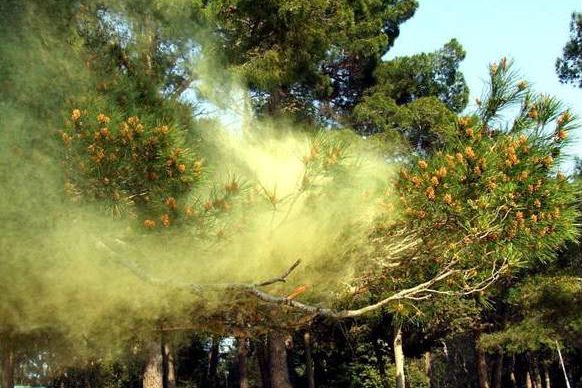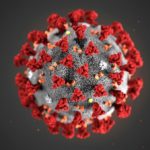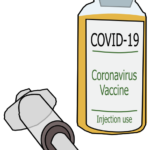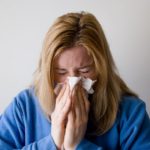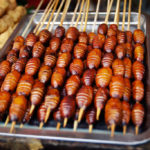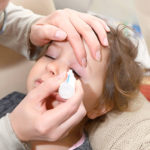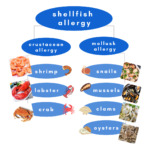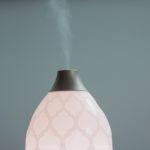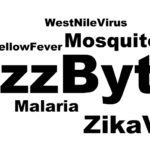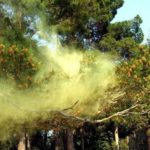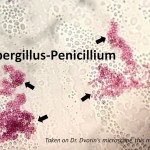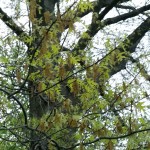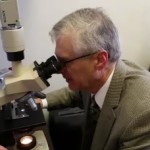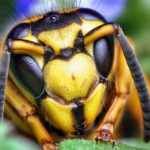allergies, allergy, allergy symptoms, Dr. Donald Dvorin, Dr. Marc Goldstein, grass pollen, mold spores, mount laurel, mulberry tree pollen, oak tree pollen, outdoor mold, philadelphia, pine pollen, pine pollen allergy, pine tree pollen, pine trees, pinelands, pollen, pollen count, southern new jersey, spring, The Asthma Center, tree pollen
Pine: Star Player Triples; Mold Batting Cleanup
For interviews and tours of the Delaware Valley’s only certified pollen and mold spore stations for the National Allergy Bureau (NAB) with stations, please email gwoodlyn@asthmacenter.com
We’ll get to our heavy hitter, Pine Tree Pollen, right after…
Today’s only official Pollen & Mold Spore Counts for the Delaware Valley:
Outdoor Mold Spores have increased to over 7000 spores per cubic meter of air for 24 hours and are extreme with the potential to provoke severe symptoms. For more on Outdoor Mold Spores and mold allergy, be sure to read yesterday’s blog Rain Brings Trouble As Mold Spores Double
Grass Pollen is increased again today and remain High. Are you ready?
For tips on Grass Pollen Preparedness, read our 5/9 blog
Overall Tree Pollen volume more than doubled today compared to yesterday. At nearly 700 pollen grains per cubic meter of air, tree pollen remains in the Very High range and may continue to provoke moderate to severe symptoms.
Pine Pollen Triples compared to yesterday and is the predominant tree pollen player in the air today.
“In our 24 hour air sample, I started seeing more pine pollen grains later in the day—considering that we have sunshine and drier conditions today, expect these numbers to increase,” reports Dr. Dvorin. “We are now in the peak of pine pollen season.”
Pine Pollen Volume Unique to the Delaware Valley
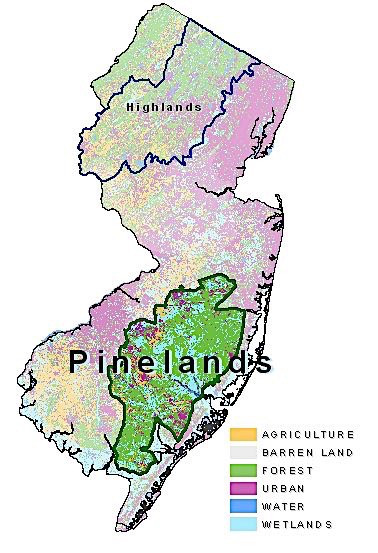
Within the heart of the Delaware Valley sits the 1.1 million acre (see map) protected open space known as the New Jersey Pinelands. Although there are over 110 different species of the pine family (Pinus), this protected area is home to the largest cluster of pitch pine, Pinus rigada (see picture below) on the United States (U.S.) Eastern coastline.
“For individuals who today are sneezing, itching, have itchy watery eyes and/or other allergy & asthma symptoms, exposure to multiple aeroallergens—what’s in the air—especially pine pollen in our air matters now,” explains Dr. Goldstein. “Pine pollen makes our region unique from an allergy perspective compared to other areas of the Northeastern U.S. where pine pollen is minimal, nonexistent, or other species are prevalent.”
Dr. Dvorin, co-founder of The Asthma Center, has been studying the tree pollen seasons in the Delaware Valley each spring for years. From the very beginning, he has observed notable pine pollen levels in both our Southern New Jersey and Philadelphia air samples.
According to Dr. Dvorin, typically pine tree pollen appears in late May through the end of June with extreme peak levels recorded over 1000 pine pollen grains per cubic meter of air/24 hours. This year, however, has not been a typical year. Pine tree pollen made an earlier than usual first appearance in mid-March, not unlike many other tree pollen species in the Delaware Valley this spring. As often noted in our daily counts and pollen blogs, pine pollen has been part of the “big three—Oak, Pine & Mulberry”—which have all been pumping tree pollen into our air and causing misery for allergy sufferers.
“We’re definitely in the height of pine pollen season,” reports Dr. Dvorin.
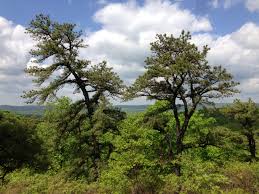
With levels tripling in the last 24 hours, pine tree pollen today is over 300 per cubic meter of air/24 hours and is the predominant tree pollen in the air, contributing nearly 50% of all tree pollen currently in the air.
Despite the abundance of pine pollen in our air samples, pine pollen allergy is often ignored.
Allergists both locally and nationally have for years felt that pine pollen is not a clinically relevant allergen, and many rarely test for pine pollen allergy. Some studies suggest that the prevalence of pine pollen allergy may range from 2%-10% of the population; however, there have been no studies that have firmly established the incidence of pine pollen allergy in the general allergic population.
Because of our region’s proximity to the Pinelands, the board certified Allergists of The Asthma Center continue to clinically recognize allergic symptoms at this time of year can be caused by pine pollen allergy. “We have included pine pollen in our allergy skin testing panel for years because we’re near the Pinelands and we know significant levels of pine pollen can be in the air,” explains Dr. Goldstein. (Read more about The Asthma Center if you are interested in being tested for pine pollen allergy.)
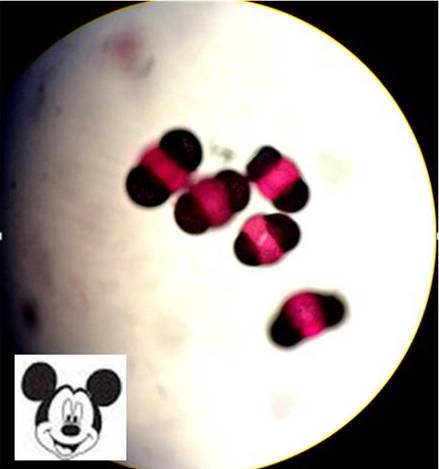
Box Score on Pine Pollen Allergy
Pine pollen grains typically bear a waxy thick coat that surrounds its rather large size (see picture). Pine pollen grains can be 60 to 100 micrometers in diameter. Pine pollen is large compared to other pollen grains (typical pollen grain size is approximately 10 micrometers). The size of pine pollen had been felt to be a reason why pine pollen might not be distributed by wind and through the air. However, studies (and Dr. Dvorin’s own pollen counts) have proven that this not the case. In fact, despite its large size, pine pollen is capable of traveling great distances.
The pine pollen grain typically has 2 large air sacks that give it a “Mickey Mouse” appearance (see picture.) These air sacks reduce the pine pollen grain density and contribute to the pollen’s buoyancy, allowing it to travel long distances in the air. As an example, the center of the Pinelands is about 40 miles from Center City Philadelphia. Yet our urban air samples from our Philadelphia, PA collection station are generally the same relative volume of pine pollen grains as found in our suburban air samples from our Mount Laurel, NJ collection station which is 30 miles from the Pinelands.
Thinking that the size of pine pollen grains were too large to enter the nasal and lung passages, many physicians (including allergists) did not consider pine pollen a relevant allergen. Evidence that it can be inhaled and provoke symptoms are found in cases reported in the medical literature as far back as 1921. Published results from limited investigation of pine pollen allergy have shown that pine pollen allergy does cause allergic responses in the skin (positive allergy skin tests) and allergy responses on nose, eye, and lung challenges.
In addition to the limited reports of pine pollen-induced hay fever or bronchial asthma, there have been reports of allergies to ingested pine nuts (the seeds of pine trees) or from pine nuts found in pesto, sauces, salads, meatballs, cakes, candies and cookies. Interestingly enough, there is very little cross reactivity of pine nuts with other tree nuts. This is due to the fact that, evolutionarily, pine nuts are not from flowers as in the case of other tree nuts (like walnut, hazelnut, cashew, pistachios), but are contained within the pine cone—making them antigenically different from other tree nuts.
Another unusual manifestation of pine pollen sensitivity is in those who have “Xmas tree allergy.” This may be due to pine pollen being released from pine cones when cut trees are hydrated in the home causing nasal, eye, and chest symptoms during the Xmas holiday season.
The board certified Allergists at The Asthma Center are very much aware, therefore of the importance of pine pollen as an important spring allergen. Many patients who previously escaped diagnosis of seasonal pine pollen allergy was due to the fact that allergy skin testing to pine pollen was not performed or was not considered as a clinically significant allergen capable of provoking symptoms. If you would like to know if pine pollen allergy is playing a role in your symptoms, The Asthma Center does routinely test for pine pollen sensitivity—contact the office location near to schedule an appointment!
Be sure to check back in for The Asthma Center’s Daily Pollen and Mold Spore Count, the Delaware Valley’s ONLY official count station which is certified by the National Allergy Bureau. Subscribe to receive our daily counts by email or check out some of our other blog posts to learn more about what is in the air, how it can affect you, and what you can do about it.
Make an appointment to see an allergist – Why Choose Us?
The best way to fight your allergies is to visit a board certified allergist, learn what your allergies are, create a treatment plan, and adjust as needed. No two allergy sufferers are alike, so don’t rely on over the counter medications when you could be targeting your symptoms with the help of our allergy experts!
Recent
Popular

